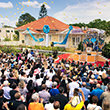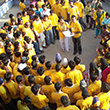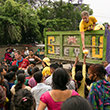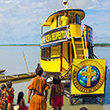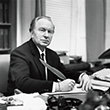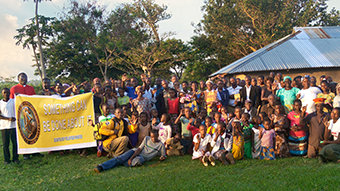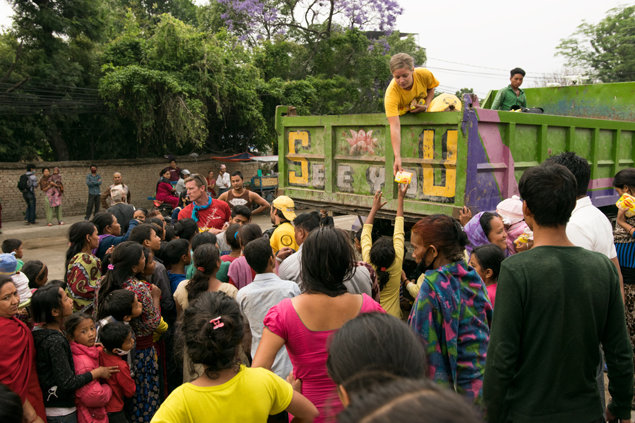
Mike Savas was vacationing in Bali, Indonesia, when a magnitude-7.8 earthquake struck the Himalayan nation of Nepal in April 2015, killing an estimated 8,969 people, destroying more than 600,000 houses and leaving some 2.8 million people in need of humanitarian assistance.
Savas, a 34-year-old San Diego-based concert producer, knew exactly what to do in the face of the disaster 3,000 miles away: Accompanied by a friend, he hopped on the next available plane to Kathmandu, Nepal’s capital.
As a longtime member of the Church of Scientology Volunteer Minister Program, Savas had participated in rescue and relief efforts following the September 11, 2001 terrorist attacks in New York City. When Hurricane Katrina struck the Gulf Coast in 2005, he did not hesitate to rush to the aid of victims. He did the same thing seven years later when Hurricane Sandy hammered the eastern United States.
Volunteer Ministers (VMs) were among some of the first groups to come to the aid of quake victims in Nepal. The Himalayan nation, difficult for tourists to negotiate at the best of times, was a chaotic mess wracked by frightening aftershocks. The earthquake had left hundreds of buildings, many of them UNESCO World Heritage Sites, badly damaged or reduced to rubble, making the task of finding survivors excruciatingly difficult.
“For three days we drove wherever we could provide first aid to victims,” said Savas, who spent a total of 12 days as a Volunteer Minister in Nepal.
Savas and his VM colleagues teamed up with an affiliated group—Los Topos, a group of volunteer firefighters, paramedics and scouts from Mexico—that was helping with the massive international rescue and relief mission underway in Nepal. The Mexican outfit, known as “The Moles” in English, is renowned for its skill in searching for earthquake and mudslide victims who are buried deep in debris. Trained in VM technology, Los Topos has been partnering with the Volunteer Minister Program ever since the two groups jointly conducted relief operations following the September 11, 2001 attacks in New York City.
Working from a base that Volunteer Ministers established in Kathmandu, Savas accompanied the 16-member Los Topos team to the worst earthquake-hit areas. They were led by the organization’s longtime first responder Héctor “El Chino” Méndez, a former accountant who founded Los Topos in the aftermath of the magnitude-8.1 earthquake in Mexico City, which claimed at least 10,000 lives in 1985. According to Savas, Los Topos volunteers combed through the rubble of collapsed buildings in Nepal, searching for earthquake survivors, getting no sleep and very little food during the first 72 hours.
Savas will never forget the day when he and other VMs came upon a village of about 2,000 people where 190 of the roughly 200 houses had been destroyed, claiming scores of lives. “A 2-year-old girl was believed to be buried alive, and our search dogs picked up her scent,” Savas recalled, adding that Los Topos members dug through the earth for several hours, unable to find her.
But then they found the girl’s brother, who had evidently been buried alive for two days. “His foot had been crushed beyond recognition, and we convinced his parents to let us take him to the U.N. base,” Savas said, adding that the timely rescue allowed doctors at the United Nations headquarters in Kathmandu to successfully treat the boy’s foot without amputating it.
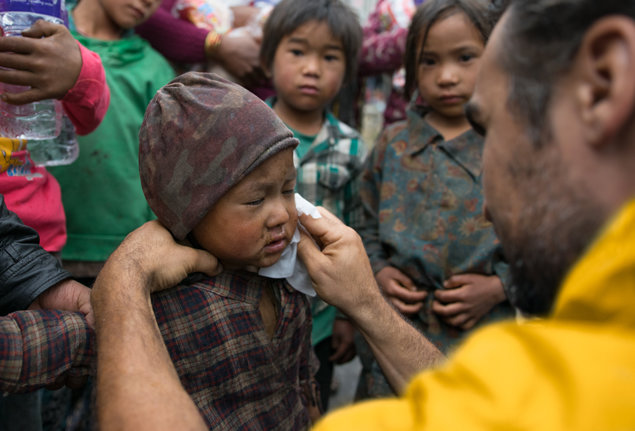
Binod Sharma, the VM director in Nepal and a native of Kathmandu, organized the materiel support for Los Topos. Sharma was riding a motorbike in the capital city when the earthquake hit four minutes before noon on April 25. His immediate reaction, he recalled, was to communicate with his family and contact other VMs to help earthquake victims.
Sharma plunged into volunteer work early the next morning. Among his first tasks was the coordination of relief efforts between VMs and a number of its partner groups, such as non-governmental organizations, youth clubs and local Boy Scouts. Hundreds of Nepalese Boy Scouts played a key role in clearing debris from roads and assisting rescue teams.
As the week progressed, Sharma pitched a trademark yellow VM tent in a Kathmandu neighborhood to provide victims drinking water and sanitation. Meanwhile, VMs teamed up with the Nepalese Army and paramilitary forces to clear the rubble from buildings in Kathmandu that were destroyed by the earthquake. What’s more, by the end of a month, VMs had built 14 temporary learning centers in eight districts across the nation, according to Sharma. In addition, the VMs built 65 temporary shelters and 500 shelters covered by tarps for victims left homeless following the quake.
The VMs even introduced a radio program, titled “Volunteer Voice,” to share the technology and achievements of VMs in the region. The program aired once a week on two national radio stations and one television channel.
“In just three months, VMs helped rebuild as many as 369 schools and buildings in 11 districts.”
One highlight of the VM relief effort was the training of new volunteers to perform “assists,” actions taken to provide relief from trauma, losses or upsets. “Many Nepalese,” said Sharma, “were very appreciative of the assists they received.”
A case in point was an elderly man to whom Sharma delivered assists during a visit to a shelter in Kathmandu, where some 1,000 victims had taken refuge. Sharma began by giving him “touch assists” aimed at reestablishing communication with his injured body parts. Then Sharma delivered “nerve assists,” which begins by stroking nerve channels along both sides of the man’s spine, then moving to other nerve channels in the body. The man expressed great relief, Sharma recalled, and thanked him profusely. He then requested the VM director to train his son in assist technology so that it could always be available to him at his home.
Because heavy monsoon rains were expected shortly after the earthquake, people living in makeshift tents were particularly vulnerable. To provide them shelter from the coming rains, VMs built 65 small houses in a village decimated by the quake. In another village, a Nepalese VM engineer and a group of Volunteer Ministers worked with a team of scouts and soldiers to build a temporary school in less than 24 hours.
“In just three months, VMs helped rebuild as many as 369 schools and buildings in 11 districts. Besides delivering 50,000 meals in 124 stricken villages, the VMs delivered 7,000 assists and trained 8,000 people in remote areas,” Sharma said, adding that VMs have forged 14 partnerships with local NGOs for future collaborations during disasters.
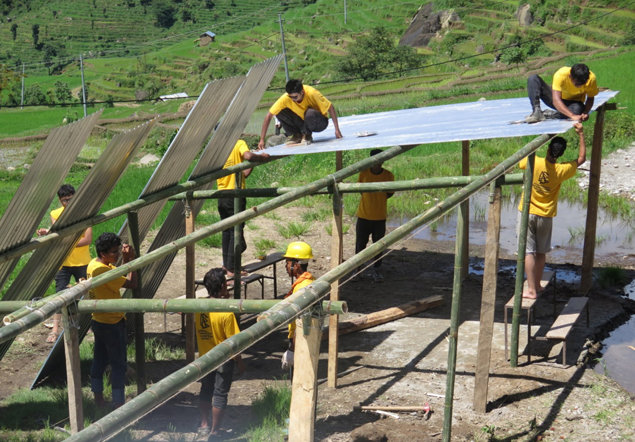
Taking advantage of a newly constructed VM center in Kathmandu, Sharma has so far trained 935 volunteers in assists, first aid, communication skills, organizing skills and “study technology”—a method of improving students’ learning. Every week, teams of up to 20 would-be volunteers travel to the center for training, bringing VM technology back to their communities.
Sharma has his work cut out as Nepal slowly recovers from the shock of the earthquake—amid an ominous forecast by the Asian Development Bank that the Himalayan nation will suffer the highest inflation and slowest economic growth in South Asia during the current fiscal year.
For starters, he plans to introduce study technology in all Nepalese schools to further empower youths. Having already created an array of new volunteers in 19 of the nation’s 75 districts, Sharma is now seeking to train volunteers across the entire nation so that they can deliver the full gamut of VM courses, besides being equipped to effectively respond to disasters in any part of Nepal. Finally, Sharma has an ambitious plan to create partnerships with some 500 organizations and NGOs to help Nepal recover from an estimated $5 billion in damages that it suffered because of the earthquake.
This past April, Nepalese Prime Minister Khadga Prasad Sharma Oli, accompanied by government officials and foreign diplomats, marked the first anniversary of the earthquake by laying a floral wreath at the ruins of an iconic nine-story watchtower in the heart of Kathmandu that collapsed in the quake, killing 132 people.
While the mainstream media focused on reporting about delays in rebuilding of homes, schools and hospitals in many areas, as one newspaper described it, turning “a natural disaster into a man-made catastrophe,” the VMs have been a consistent force in helping the people of Nepal recover from one of the most damaging earthquakes in recent times.
As it happened, the VM relief and reconstruction efforts were applauded by none other than Premier Oli. In the weeks following the earthquake, he personally thanked Sharma for the valuable work of the Volunteer Ministers. The VM director also received a formal certificate of thanks from Gagan Kumar Thapa, a member of Nepal’s Parliament.
Perhaps the most gratifying commendation, however, came right in the midst of the disaster. As veteran VM Savas tells it, a local UN official “came up to us and said, ‘Not only are we proud of you—we’re jealous of you.’”


